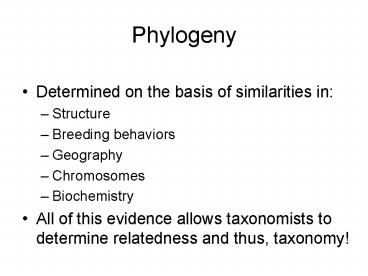Phylogeny - PowerPoint PPT Presentation
1 / 10
Title:
Phylogeny
Description:
Defined by novel homologies. Introduced characteristics called derived characters. Shows evolution of orgs as well as the novel characters which define their grouping ... – PowerPoint PPT presentation
Number of Views:41
Avg rating:3.0/5.0
Title: Phylogeny
1
Phylogeny
- Determined on the basis of similarities in
- Structure
- Breeding behaviors
- Geography
- Chromosomes
- Biochemistry
- All of this evidence allows taxonomists to
determine relatedness and thus, taxonomy!
2
Cladistics
- Part of Systematics
- Clade evolutionary branch
- Organizes Orgs. In order of evolution
- Defined by novel homologies
- Introduced characteristics called derived
characters - Shows evolution of orgs as well as the novel
characters which define their grouping
3
Cladogram vs. Comparative (Traditional)
Morphology p.452
Derived Characters
lt-- Common Ancestor
? ?
Common Ancestor ?
Common Ancestor ?
4
Cladistics
- A system of classification based on phylogeny
- Uses cladograms
- What does a cladogram tell you?
5
Fan Diagrams
- How are fan diagrams different from cladograms?
6
The 6 kingdom debate
- The discovery of Archaea led one team of
scientists, led by Carl Woese, to propose a new
taxa - DOMAIN (SUPERKINGDOM)
- ABOVE KINGDOM
7
Three Domain System
- 1990s
- Domain is larger classification than Kingdom
- Used Technology to compare Ribosomal RNA
sequences of organisms from bacteria to animals - Determined how long organisms had been evolving
independently - Shows Evolutionary Relationships
- Uses molecular clock to determine how long ago
orgs were related - Based on how many sequences are different ( of
mutations, order of mutations)
8
Three Domain System
- 1. Domain Bacteria
- Corresponds to Eubacteria Kingdom
- Unicellular Prokaryotic Organisms
- No Nucleus
- Ecologically Diverse live everywhere!
- Metabolically Diverse
- Cell Walls contain substance called Peptidoglycan
special protein and sugar - Trait used to distinguish between
- Bacteria and Archaea
- Target of many Antibiotics
9
Three Domain System
- 2. Domain Archaea Ancient Bacteria
- Corresponds to Kingdom Archaeabacteria
- Unicellular, Prokaryotes
- Metabolically Diverse
- No nucleus
- Live in Extreme environments like those of early
Earth - Cell walls without Peptidoglycan
- A trait used to distinguish between Archaea and
Bacteria Domains
10
Three Domain System
- 3. Eukarya
- Contains Kingdoms
- Protista, Fungi, Plantae, Animalia
- Eukaryotic, single or multi-cellular Organisms
- Nucleus
- Most visible life
- Humans are in Domain Eukarya































